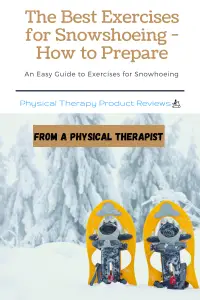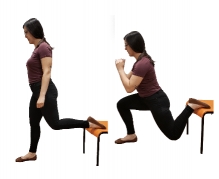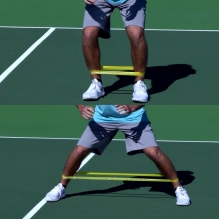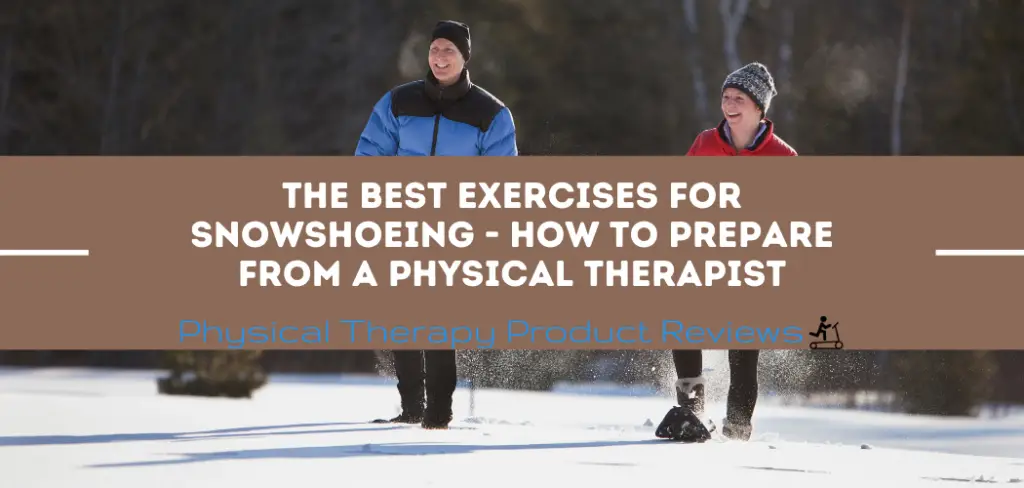 Snowshoeing is an ancient sport that has continued in popularity over the millennia. Perhaps the average athlete no longer uses the sport to hunt down herds of prey in the tundra, but it’s still a fun way to enjoy some winter adventure.
Snowshoeing is an ancient sport that has continued in popularity over the millennia. Perhaps the average athlete no longer uses the sport to hunt down herds of prey in the tundra, but it’s still a fun way to enjoy some winter adventure.
Ensuring that you keep proper form while snowshoeing can help you avoid injury and missing out on that fresh powder. Below, you’ll find a list of exercises to incorporate into your routine to ramp up your performance and decrease pain while snowshoeing.
The Muscles at Work While Snowshoeing
Snowshoeing takes a lot of energy! The demands are far beyond simply walking. With snowshoeing, one must navigate deep snow, varying terrains, weather conditions, and manage equipment.
The main muscle groups that are active during snowshoeing are:
- Hip Flexors: the muscles responsible for lifting your leg to take a step.
- Hip Adductors: your groin muscles. When taking wider steps to snowshoe, these can take on extra stress.
- Glutes: these muscles are powerful hip extenders, helping to propel you forward for your next step.
Proper Snowshoe Technique and Form:
As with any activity, proper form is essential. There are many details regarding the right way to traverse a slope or get up from a fall, but for this article, we’ll focus on the physical motion of standard snowshoeing.
Form:
Just like walking on flat terrain, step one foot in front of the other. You will need to widen your steps slightly to account for the width of your snowshoes.
Avoid:
Try not to hunch forward while you walk. Stand upright, just like you would normally.
Pole Technique:
As your left foot steps forward, your opposite hand will move forward as well to plant your pole in the snow in line with your foot. Trekking poles, though optional, will add stability and help include your upper body in the exercise.

Exercises for Snowshoeing
Consider these supplementary exercises to support your snowshoeing practice. Whether you’re looking to enhance your performance or decrease pain and injury
To Improve Snowshoe Performance:
Adding snowshoe training to your program 3x/week can improve your VO2max by about 12%.
Add in these exercises to help further upgrade your snowshoeing performance:
- Jump Squat: Stand with your feet slightly wider than shoulder distance. Descend into a squat, then powerfully rise with a jump, allowing your feet to leave the ground. Drop quickly, but with control, back into a squat and repeat. Go for speed and fatigue. Jump squat video tutorial.
- Core Stabilization: Use exercises like planks, side planks, Birddog, and bridges to work your core.
 Bulgarian Split Squats: Stand one pace in front of your couch. Place one foot behind you, on top of your couch. Descend into a lunge, ensuring that your front knee does not pass beyond your toe. Rise up to stand and repeat. Bulgarian Squat video tutorial.
Bulgarian Split Squats: Stand one pace in front of your couch. Place one foot behind you, on top of your couch. Descend into a lunge, ensuring that your front knee does not pass beyond your toe. Rise up to stand and repeat. Bulgarian Squat video tutorial.- Add hand weights to increase the challenge.
- Challenge your Single Leg Balance: Yoga poses like Tree and Half Moon will seriously test your single-leg balance. Practicing positions like this will improve your core strength, coordination, and your stabilizing muscles.
Step it up a notch: Consider adding Snowshoe running to your routine.
Pre-season: Before the snow comes, you can prepare yourself for the season with the exercises above and trail running or hiking, with or without poles.
To Decrease Pain with Snowshoeing:
A physical therapist can provide you with a specific and detailed rehab program if you have an injury or persistent issue. The exercises below will serve as guidance for slight nags and soreness that may be holding back your snowshoeing advancement.
- Step up progressions: Stand in front of a set of stairs. With one leg, step up one or two stairs, and bring the other foot up to the same level. Then step down and return to your starting position. Maintain your balance throughout the motion and avoid leaning side to side.
- Increase the challenge of this exercise by adding hand weights.
- Monster walk: This is an excellent exercise for increasing the strength of the muscles that support you during single-leg activities. Tie a resistance band around your knees. Take a side step to the right, then use control to bring your left foot in to meet the other. Continue moving in a side step for 20 paces. Then sidestep to the left for the same number of repetitions.
- Increase the challenge by moving the resistance band down to your ankles.

- Single leg deadlifts: Begin in the standing position. Slowly lift one leg up behind you while you pivot forward from the hips. Aim to get your body parallel to the ground. Maintain a flat back and do not hunch. Avoid leaning your body to the side or twisting your hips. Slowly return to stand. Repeat for even repetitions on each side.
- Increase the challenge by adding hand weights or a resistance band.
- Stretches: Don’t forget to stretch! Discomfort during snowshoeing can originate from tense and inflexible muscles. Give particular focus to these muscle groups: hip flexor, quads, calves, groin/hip adductors, back extensions.
- Hold a stretch for about 30 seconds and repeat it three times on each side.
- Mobilize: Use soft tissue mobilization tools like a foam roller, runner’s stick, and massage ball to localize manual pressure to stiff and sore muscles.
- Tip: the runner’s stick works very nicely on the muscular part of the shin (not over the bone) to address soreness from lifting the toes.
Cross-Train: during the season, use lower impact exercise to maintain your fitness but give your joints a break. Add in exercises like swimming, elliptical, cross country skiing, hiking with poles.
A Few Helpful Tips for Snowshoeing:
- Maintain your endurance during the off-season by trail running or hiking with poles.
- Mix up your activity by including both long and slow snowshoe outings and fast and challenging routes. A varied week makes for a more adaptable athlete.
- Bring a buddy! Snowshoeing with a pal can invite you to work harder or in a different way. Workout buddies are also great for observing your form and pointing out downfalls that you might not notice yourself.
- As always, be safe. Practice smart procedures and have a backup safety plan. Leave no trace, mind the wildlife, and protect natural areas to the best of your ability.
Conclusion
Snowshoeing is incredible fun and a terrific form of exercise. Treat your body right, and it won’t slow you down. Now you’ve got the knowledge and the power to fuel your snowshoeing enthusiasm – get out there and break trail!
Works Referenced:
Beginner’s Guide to Snowshoeing. REI. https://www.rei.com/learn/expert-advice/snowshoeing-first-steps.html
Browning RC, Kurtz RN, Kerherve H. Biomechanics of walking with snowshoes. Sports Biomechanics. 2011.
Connolly DAJ, The energy expenditure of snowshoeing in packed vs. unpacked snow at low-level walking speeds. Journal of Strength and Conditioning Research. 2002; 16(4): 606-610.
Other Great Rehab Related Articles
GLP Weight Loss and Back Health: Effective Strategies and Insights
How to Stay Active After Cervical Fractures: Expert Tips and Advice
Dealing with Painful Stairs After Ankle Replacement Surgery
Walking After a Total Ankle Replacement: Tips for a Successful Recovery
Exercises While Non-Weight Bearing After Ankle Replacement: Elevation, AROM, Leg Raises, and More
Ankle Pain with Stairs: Causes and Home Treatment Options
Disclaimer: The information provided in this post is for educational purposes only. This is not a substitute for a medical appointment. Please refer to your physician before starting any exercise program.






